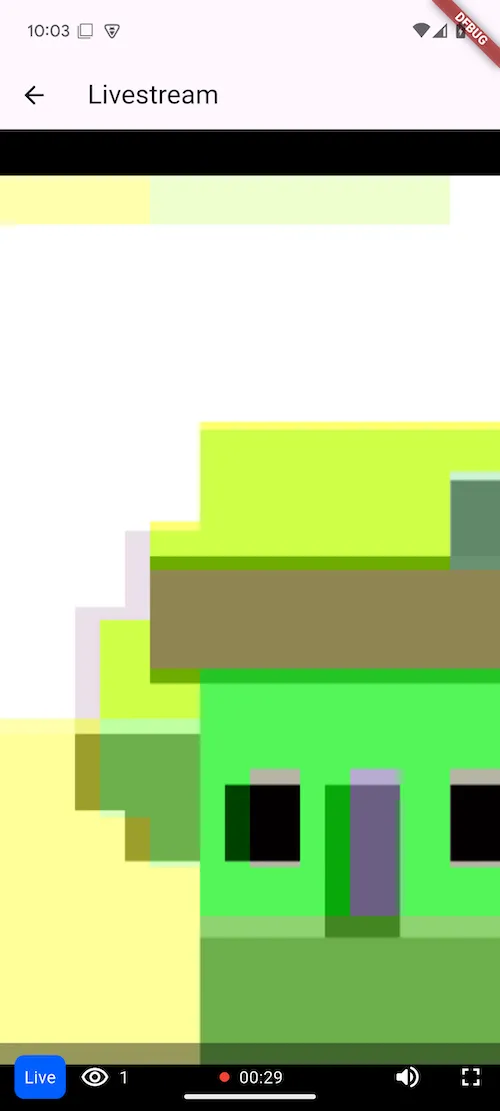final url = call.state.value.egress.hlsPlaylistUrl;Watching a Livestream
This guide demonstrates how to build advanced UIs for watching livestreams in your Flutter applications using Stream’s Video SDK.
This cookbook assumes you already know how to join a livestream call.
If you haven’t completed the Livestream Tutorial yet, we recommend doing so before proceeding.
Overview
Stream’s Video SDK supports two methods for watching livestreams:
- HLS (HTTP Live Streaming) - enables reliable large-scale broadcasting with broad device compatibility and adaptive quality. While it has higher latency (5-30 seconds), it excels at reaching large audiences with stable playback
- WebRTC - provides ultra-low latency streaming (sub-second) - perfect for interactive experiences like live auctions or Q&As where real-time engagement is critical
HLS Streaming
We can then obtain the HLS URL by querying the hlsPlaylistURL from call.state:
To view HLS streaming with quality selection and playback controls, we recommend using the lecle_yoyo_player package.
WebRTC Streaming
For WebRTC livestreams, you can either:
- Use our pre-built
LivestreamPlayercomponent - Create your own custom implementation
Using the LivestreamPlayer
Our LivestreamPlayer widget provides a complete livestreaming experience with these built-in features:
- Live indicator showing when the stream is active
- Real-time livestream duration display
- Viewer/participant counter
- Full-screen mode toggle
- Handling various livestream states like backstage or call ended

Basic Implementation
To use the LivestreamPlayer, simply provide a Call instance:
LivestreamPlayer(call: call);Customization Options
The LivestreamPlayer supports extensive customization:
| Property | Description | Default |
|---|---|---|
joinBehaviour | Defines the behavior for automatically joining the livestream. | autoJoinAsap |
connectOptions | Call options used when joining the livestream. | Microphone and camera disabled |
showParticipantCount | Controls visibility of participant count. | true |
backButtonBuilder | Custom builder for the back button. | None |
livestreamEndedWidgetBuilder | Custom builder for when the livestream has ended. | Default ended view |
livestreamBackstageWidgetBuilder | Custom builder for backstage mode view. | Default backstage view |
livestreamControlsWidgetBuilder | Custom builder for livestream controls. | Default controls |
onCallDisconnected | Callback when the call disconnects. | None |
onRecordingTapped | Callback when the recording button is tapped. | None |
onFullscreenTapped | Callback when the fullscreen button is tapped. | Changes the VideoFit between cover and contain |
startInFullscreenMode | Whether the livestream should start in fullscreen mode. | false |
pictureInPictureConfiguration | Configuration for picture-in-picture mode. | None |
Minimal Player Example
To create a minimal player without the default controls panel:
LivestreamPlayer(
call: _call,
startInFullscreenMode: true, // Optional fullscreen mode
livestreamControlsBuilder: (context, call, callState) => const SizedBox.shrink(),
)This configuration preserves the built-in handling of backstage mode and ended states, while hiding the default controls panel. This gives you complete flexibility to build custom controls and overlays on top of the video player.
Building a Custom Livestream Player
You can create your own livestream player component for complete control:
@override
Widget build(BuildContext context) {
return SafeArea(
child: StreamBuilder(
stream: _call.state.valueStream,
initialData: _call.state.value,
builder: (context, snapshot) {
if (!snapshot.hasData) {
return const Center(child: CircularProgressIndicator());
}
final callState = snapshot.data!;
if (callState.endedAt != null) {
return const Center(child: Text('Livestream has ended'));
}
if (callState.isBackstage) {
return const Center(child: Text('Host is backstage. Stream will begin soon.'));
}
// Render the actual livestream content
return _buildLivestreamContent(context, callState);
},
),
);
}Accessing Livestream Tracks
To render the actual livestream video, you need to have access to the livestream track (or tracks).
If there is only one video track (you only have one person livestreaming), you can get it with the following code:
final streamingParticipant =
callState.callParticipants.firstWhere((e) => e.isVideoEnabled);If you have multiple hosts that are livestreaming, and you want to show them all, you can fetch the hosts by role:
final streamingParticipants = callState.callParticipants
.where((p) => p.roles.contains('host'))
.toList();To render the video track you can use our StreamCallParticipant widget:
StreamCallParticipant(
key: ValueKey(participant.uniqueParticipantKey),
call: call,
participant: streamingParticipant,
showConnectionQualityIndicator: false,
showParticipantLabel: false,
showSpeakerBorder: false,
)Additional Resources
For more Video SDK examples, check out our Flutter Cookbook samples on GitHub.